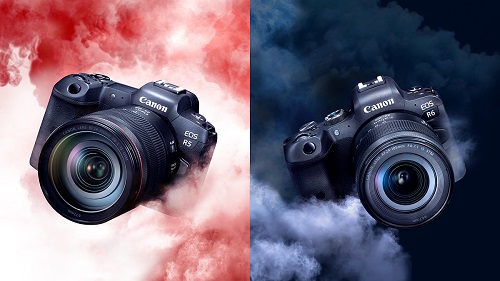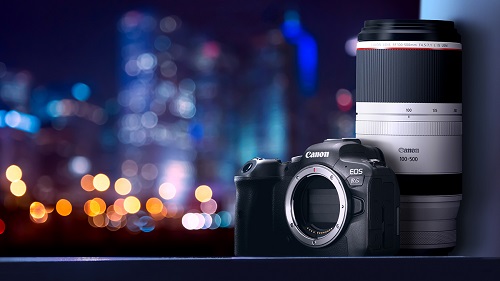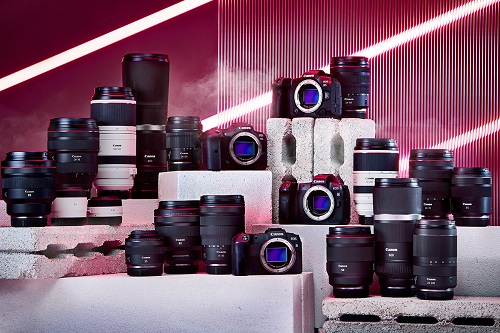
Canon announced the launch of two brand new full-frame mirrorless cameras under the EOS R lineup: the Canon EOS R5 and EOS R6. These new EOS cameras are aimed at advanced amateurs and professionals and were designed to provide a high-quality, high-speed shooting experience. Equipped with a new and improved AF system, fast continuous shooting speed of up to 20 fps and in-body IS, the EOS R5 and EOS R6 also come with dual card slots.
With a 45-megapixel full-frame CMOS sensor that is approaching medium-format resolution territory, the Canon EOS R5 is able to meet the exacting demands of professionals. From large format commercial printing, capturing intricate details in landscape photography, and even intensive cropping frequently required in wildlife photography, the EOS R5 is able to do them all.
Powered by the new DIGIC X image processor, which debuted in the flagship EOS-1DX Mark III, the electronic shutter in both the EOS R5 and EOS R6 is capable of a continuous shooting speed of up to 20fps at full resolution, even with AF and AE tracking. The mechanical shutter is able to shoot at a continuous shooting speed of 12fps as well, placing both cameras among the fastest full-frame mirrorless cameras in the market.

The new DIGIC X imaging processor also has vastly improved noise handling capabilities. Despite having 45 million pixels, the EOS R5’s native ISO can go up to an incredible 51,200, with the option to expand to 102,400. Despite having 50% more pixels compared to the EOS R, the EOS R5 performs better in the ISO department.
The EOS R6 is equipped with a 20-megapixel full-frame sensor, which is inherited from the flagship EOS-1DX Mark III. Sharing the same image sensor and image processor as the EOS-1DX Mark III, the EOS R6 is capable of achieving a native ISO of up to 102,400 (expandable to 204,800)
For years, the high-speed, high-precision Dual Pixel CMOS AF has been the core Auto Focus (AF) technology behind Canon’s best cameras. With the EOS R5 and EOS R6, this proprietary technology has been upgraded to the next generation by enhancing the image-reading speed of the CMOS sensor. The Dual Pixel CMOS AF II coupled with the blazing fast processing speed of the new DIGIC X imaging processor has brought about several major improvements in auto-focusing capability.
Also Read: Canon EOS R5: Canon’s Peerless Full- Frame Mirrorless Camera

Another first for Canon’s EOS series cameras, both camera bodies of the EOS R5 and EOS R6 incorporate a 5-axis camera-shake blur correction In-Body Image Stabilizer (In-Body IS) function. When used in tandem with an Optical Image Stabilizer (Optical IS)-equipped RF lens, or even with RF lenses that do not have IS, the camera-shake blur reduction is as effective as up to 8-stops decrease in shutter speed. Users would also gain image stabilization when using EF lenses that do not have Optical IS.
Both cameras use a new algorithm, made possible by the new imaging engine DIGIC X, to process gyro signal data and achieve higher image stabilization effects. Coordinated control utilizes the image stabilization mechanisms of both the camera and lens, simultaneously. This coordinated control results in an optimized stabilization across the entire zoom range, from wide-angle to telephoto, depending on the lens in use.
Despite its compact size, the EOS R5 has two card slots that can accommodate one CFexpress card and one SD memory card. The CFexpress card supports high-speed transfer, allowing the camera to perform continuous shooting of 45-megapixel still images, at up to 20 fps, as well as internal recording of 8K RAW movies (without additional recording equipment). The EOS R6 has two card slots that accommodate both SD memory cards.

The incredible processing power of DIGIC X, coupled with the ultra-fast CFexpress media, enables the EOS R5 to record 8K movies at a smooth 30fps with full sensor readout. Shooting in 8K allows flexibility in cropping during post-production even for 4K delivery, allowing more creative expression through zooming or panning.
In addition, there is an option to record 8K RAW movies internally without any external accessories. The EOS R5 is also capable of recording up to 120fps in 4K as well, a feature that is highly sought after in the industry. A variety of file formats are available, including RAW, H.265 HEVC and H.264 MP4 in either ALL-I or IPB compression.
The EOS R6 is able to shoot 4K videos at up to 60fps, and slow motion at 120fps in Full HD, all without crop similar to EOS R5. The beauty is that Dual Pixel CMOS AF will be available in all resolutions and formats for both EOS R5 and EOS R6. All these video features make the cameras great tools for video makers and hybrid shooters.

External monitoring and recording are available via HDMI port at up to 4K 60fps with 10 bit, 4:2:2 for both cameras. For HDR shooting, both cameras have PQ and Canon log features that allow users flexibility in recording and grading for HDR content.
Both the EOS R5 and EOS R6 have a magnesium alloy body, as well as dust and drip-proof construction. The camera bodies that are not only lightweight, but also prevent dust and water droplets from entering the camera body as well.
In terms of shutter durability, the EOS R5 has the same 500,000 cycles shutter durability as the EOS-1DX Mark III while the EOS R6 has a 300,000 cycles shutter durability. Additionally, the shutter curtain of both cameras can be configured to either close or remain open when power is off. This is extremely useful as it can prevent dust from entering the sensor chamber during a lens change.
The Canon EOS R5 sports a top LCD panel while EOS R6 has a Mode Dial. The popular Multi-controller and Quick Control Dial, which were available on the EOS 5D series, can be found on both models. This allows quicker selection of AF points and changing of settings on both the EOS R5 and EOS R6.
The Canon EOS R5 houses the most advanced wireless features in any Canon cameras to date. It has native support for both 5GHz and 2.4GHz wireless LAN without the need for any additional accessory, which is a first for a Canon camera. FTP and FTPS data transfer are supported as well. With these connectivity features, photographers can easily transfer image data from the camera to a smart device, PC or even FTP server.
Prices are not yet announced but we will soon update this post as soon as we get these information from Canon Philippines.
More information can be found at the Canon Philippines website.





